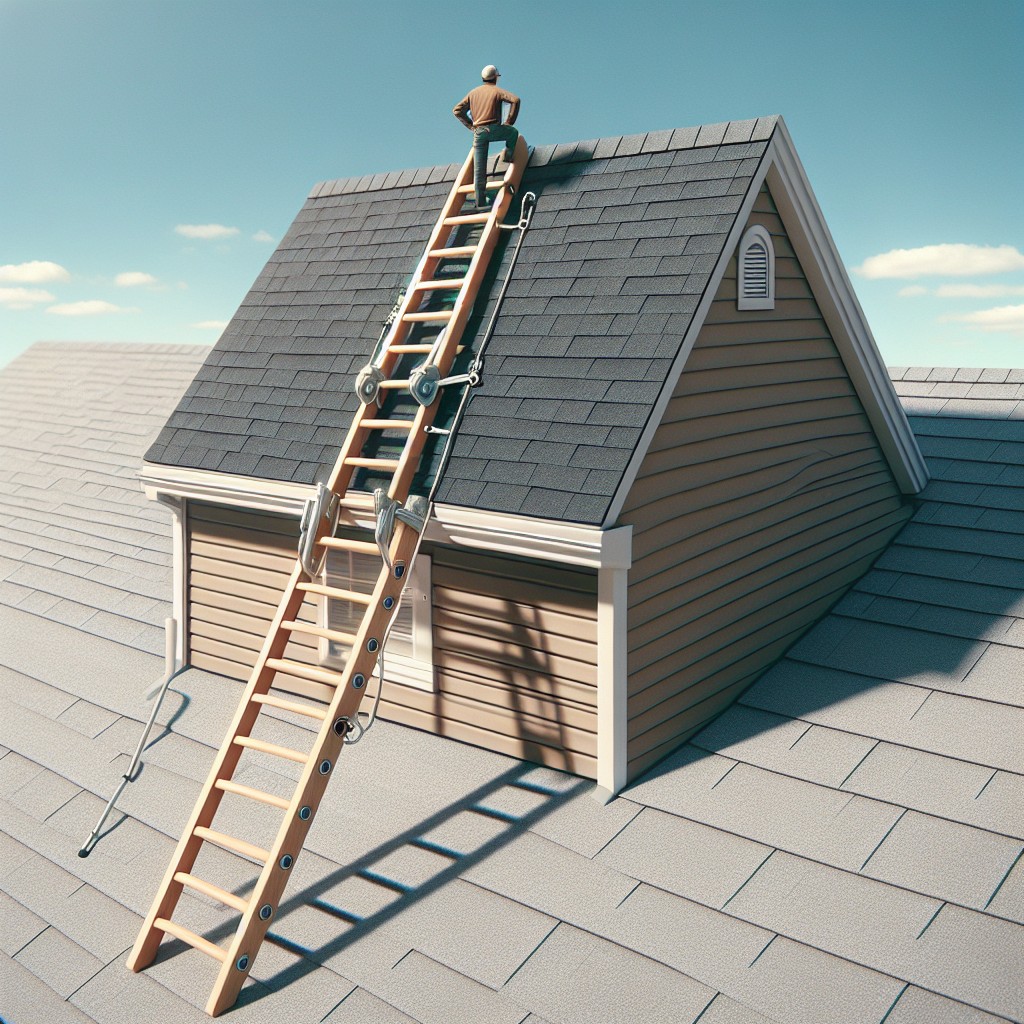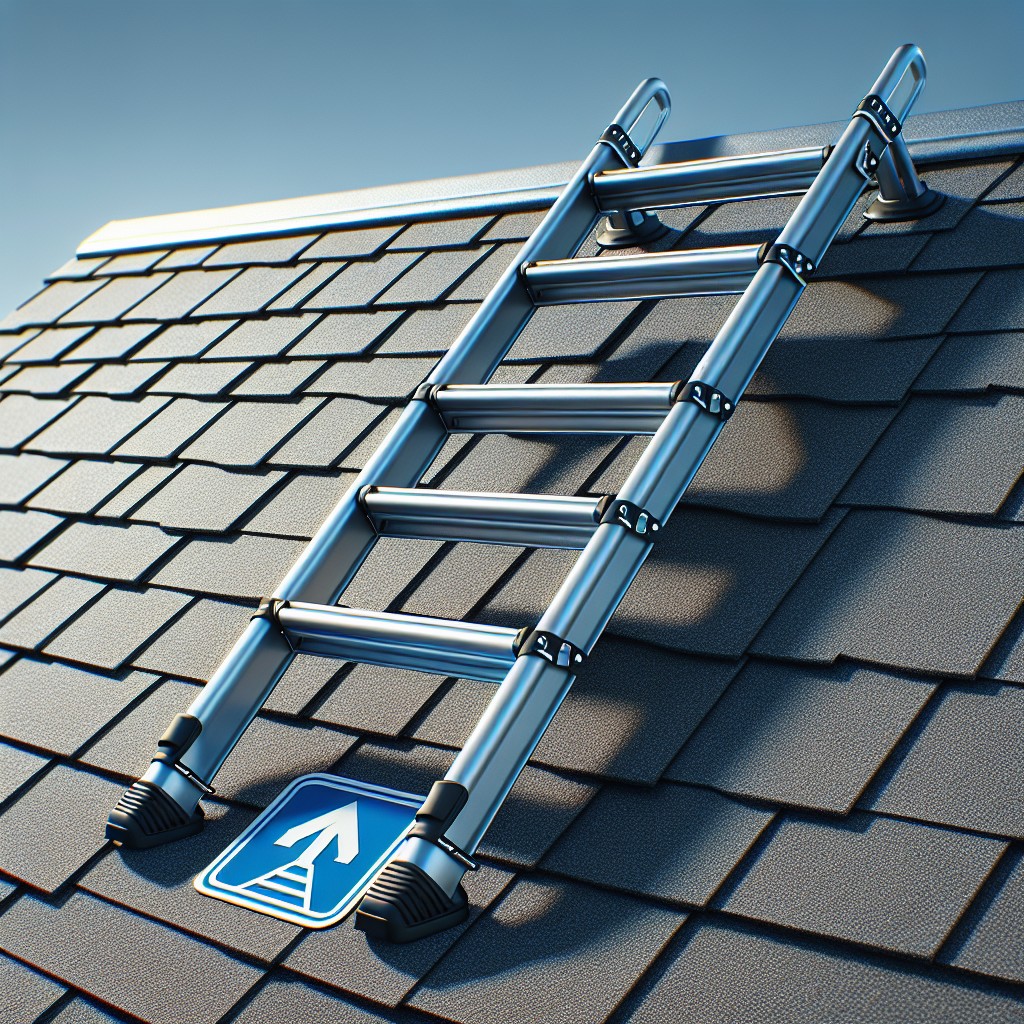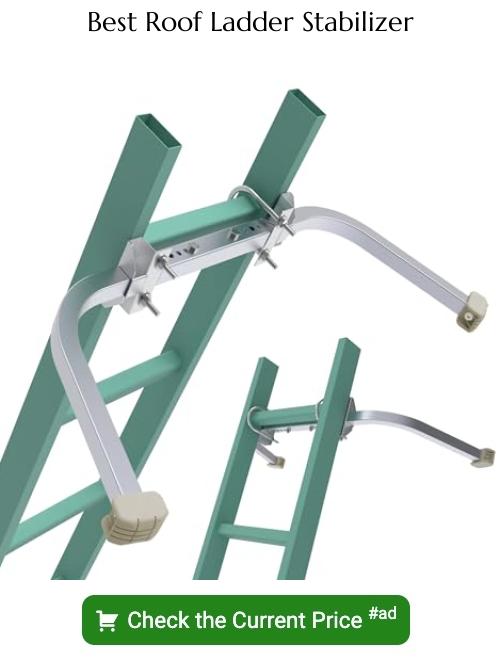Last updated on
Uncover the nuanced advantages of using a roof ladder because they ensure safety and streamline your roofing activities, making maintenance tasks a breeze.
Navigating the slope of a roof requires a specialized tool designed for safety and efficiency: the roof ladder. These indispensable aids meld adaptability and durability, offering a stable foothold regardless of weather exposure or the burden of materials.
Safety is enhanced through thoughtfully integrated features like hooks to secure the ladder in place, wheels for ease of movement, and rubber grips to prevent slippage. User-friendly attributes, including lightweight construction, simplify transportation and setup.
Moreover, understanding ladder duty ratings is essential to ensure you choose a model that can support the necessary weight, maintaining stability and safety. Whether you’re a professional roofer or a diligent homeowner, this article provides a comprehensive guide to selecting a reliable roof ladder that meets your specific needs.
Key takeaways:
- Adaptability: Roof ladders are tailored for secure footing on roofs.
- Durability: Built to handle the elements and the weight of roofing materials.
- Safety Enhancements: Equipped with hooks, wheels, and rubber grips.
- User-friendly attributes: Lightweight and easy to transport and set up.
- Ladder Duty Rating: Consider weight capacity to maintain stability and safety.
Understanding Roof Ladders

Roof ladders are specialized tools designed to provide a secure means of access to roofs for maintenance, inspection, or construction purposes. Their unique features differentiate them from standard ladders:
- Adaptability: These ladders are specifically tailored to accommodate the pitch and surface of a roof, ensuring a more secure foothold for the user.
- Durability: Crafted to withstand the rigors of the roofing environment, their construction is more robust to handle the elements and the weight of roofing materials.
- Safety Enhancements: Equipped with ridge hooks, wheels, and rubber grips, roof ladders mitigate the risk of slippage and enhance stability on inclines.
- User-friendly attributes: Ease of transport and setup is paramount. Lightweight models promote increased maneuverability without compromising strength.
In essence, roof ladders are the bridge between safety and efficiency when working on a variety of roofing projects.
Ladder Style

Roof ladders come in a variety of styles, each designed to cater to specific roofing tasks and user preferences. Extension ladders are favored for their versatility and length, which can be adjusted to suit varying roof heights. Hook ladders, on the other hand, specifically feature a hook at the top to securely grip the rooftop, ensuring stability when working at an incline.
Folding ladders are appreciated for their compact storage and transport capabilities, while telescopic ladders offer a fine balance between adjustability and ease of use. Articulating or multi-position ladders stand out for their ability to convert into step ladders, extension ladders, or even scaffold systems, making them a multi-functional choice for diverse roofing scenarios.
Ladder Size (Length)

Selecting the appropriate ladder length is crucial for both the task at hand and your safety. Measure the height you need to reach and add an extra two feet to ensure a secure overlap with the roof edge. For single-story structures, a ladder that extends 3 to 4 feet past the gutter line is sufficient, while multi-story buildings will require longer lengths for safe access.
Keep in mind that the ladder angle matters: a standard pitch is 75 degrees from the ground. For every four feet of height you climb, the base should be one foot away from the sidewall. This ratio maintains the ladder’s stability and helps prevent tipping.
When purchasing or renting, check that the ladder can retract to a manageable size for storage and transport. Also, consider the maximum extended length to verify it suits the job without compromising safety. Ladder length dictates both usability and convenience, so choose with both the project scope and storage capabilities in mind.
Ladder Duty Rating

Ladder duty ratings specify the maximum weight capacity that a ladder can safely support. These are determined by the American National Standards Institute (ANSI) and are categorized as follows:
- Type III (Light Duty) – Suitable for light household applications, they can hold up to 200 pounds.
- Type II (Medium Duty) – For more extensive home maintenance, these sustain up to 225 pounds.
- Type I (Heavy Duty) – Handling up to 250 pounds, these are reliable for heavier home and commercial use.
- Type IA (Extra Heavy Duty) – These robust ladders can bear a weight up to 300 pounds and are geared for industrial applications.
- Type IAA (Special Duty) – Designed for the most demanding tasks, they can support up to 375 pounds.
When selecting a roof ladder, consider the combined weight of the user, along with any tools or materials that will be carried onto the roof, to ensure it falls within the safe range prescribed by the ladder’s duty rating. This is not just about the ability to hold weight; it’s about ensuring stability and safety throughout the ladder’s use. Overloading a ladder above its rated capacity significantly increases the risk of injury due to ladder failure. Always choose a ladder with a duty rating that exceeds your anticipated needs to maintain a margin of safety.
Ladder Materials
Aluminum and fiberglass are the primary materials used in the construction of roof ladders, each with distinct advantages.
Aluminum is lightweight, making it easy to carry and maneuver. However, it conducts electricity and may not be suitable for work near power lines.
Fiberglass, while heavier, is non-conductive, offering an added layer of safety for electrical work. It’s also known for being durable and resistant to weather conditions.
Both materials require inspection for wear and damage before use to ensure safety and performance.
Roof Hook Design
A well-designed roof hook is integral to the functionality of a roof ladder, as it ensures secure anchorage to the rooftop.
Typically made of durable metals, these hooks attach over the roof’s ridge, providing a stable platform for work.
Safety mechanisms often include a rubber grip on the underside, minimizing damage to roofing materials and enhancing hold.
Some models feature adjustable hooks to accommodate different roof pitches, while others have fixed dimensions.
It’s crucial to engage the hook securely; improper engagement can compromise safety.
Regular inspection and maintenance of the hook’s integrity are also essential to ensure it remains reliable over time.
Superior Grip
A roof ladder’s grip is crucial to ensure stability and safety. Rubberized feet and anti-slip tread patterns on the rungs contribute to a ladder’s superior grip. These design elements prevent the ladder from sliding or shifting underfoot, particularly when ascending or descending at steep angles.
Additionally, some ladders incorporate serrated rungs to enhance traction in various weather conditions. Ladder manufacturers often use advancements in material technology to improve grip, such as incorporating fiberglass with a non-skid surface for added durability and security. It’s important to regularly check the grip on a ladder’s feet and rungs for wear and tear to maintain optimal safety.
Hooks and Stabilizers
When selecting a roof ladder, paying close attention to the design of hooks and stabilizers is crucial. These components play a pivotal role in ensuring the ladder remains securely attached to the roof’s peak or edge.
- Designed for Stability: Hooks typically curve over the roof ridge, anchoring the ladder in place to prevent slipping. They must be robust enough to withstand the weight of the user plus any tools or materials.
- Rubberized Padding: To protect roofing materials from damage, hooks often feature rubber or foam padding.
- Adjustable Length: Stabilizers or standoffs extend outward on both sides of the ladder, providing a wider footprint. This helps distribute weight more evenly and offers greater stability.
- Compatibility: It’s essential to select hooks and stabilizers that are compatible with the type of roof and ladder you are using; some are specifically designed for certain roof pitches and materials.
- Easy Installation: Many hooks and stabilizers are designed for easy attachment and detachment, facilitating smooth movement and repositioning of the ladder for comprehensive roof access.
Investing in quality hooks and stabilizers not only improves safety but also enhances the functionality of roof ladders, creating a secure work environment for various tasks.
Accessories for Improving Ladder Stability
When working at heights, stabilizing your roof ladder is crucial to ensure safety and prevent accidents. Various accessories can be utilized to enhance stability:
- Ladder Levelers: These adjustable legs compensate for uneven ground surfaces, ensuring your ladder rests securely.
- Standoff Stabilizers: Also known as ladder ‘wings’ or ‘stand-offs’, these accessories keep the ladder a consistent distance from the wall, distributing weight more evenly and protecting gutters or roofing.
- Anti-slip Mats: Placing these beneath ladder feet offers increased friction, reducing the risk of slippage.
- Ladder Anchors: These devices firmly anchor a ladder to the roof, crucial for steep inclines or slick surfaces.
- Safety Straps: Straps fasten the ladder to a solid anchor point, adding another layer of security in preventing movement.
Select the right accessory combination considering factors like roof slope, ladder type, and weather conditions to optimize ladder stability and minimize hazards.
Safety First!
Prioritize safety at every step by ensuring secure footing and maintaining three points of contact when ascending or descending ladders.
Always inspect for damage before use, and avoid wet or windy conditions which can compound risks.
It’s crucial that someone holds the base of the ladder, and remember never to overreach – move the ladder instead.
Equip yourself with a harness and rope for added security during extensive roof work, and be sure to adhere to OSHA regulations and the ladder manufacturer’s guidelines.
Heavy-Duty Roofing Ladders
When tackling roofing projects, professionals often rely on heavy-duty ladders designed to endure the day-to-day strain. These ladders are characterized by their robust construction materials, often aluminum or fiberglass, which provide durability without excessive weight. The rungs are typically reinforced to withstand frequent use and sometimes are serrated or textured to minimize the risk of slipping.
Additionally, heavy-duty varieties come equipped with wider stabilizer bars at the base to enhance stability on a range of surfaces. This is crucial when working at significant heights or where the ground may be uneven. The inclusion of safety features, such as locking mechanisms for hooks and clasps, ensures the ladder remains securely attached to the roof edge.
These ladders are also designed to have a higher duty rating – the maximum weight capacity including the user and materials – making them a reliable choice for carrying heavy loads of shingles or tools. Whether working on a steep-slope residential roof or a flat commercial project, selecting a ladder that meets the demands of the task at hand is imperative for safety and efficiency.
The Goat Steep Assist
Crafted for roofing professionals tasked with navigating steep slopes, The Goat Steep Assist system offers an innovative approach to enhance safety and efficiency. It consists of a series of poles that can be linked and extended to match the length of the roof. At the top end, a specially designed ridge hook securely grips the roof’s apex, providing a stable anchor.
A retractable handgrip slides along the length of the pole, allowing roofers to maintain a secure handhold as they move up and down the incline. The Goat’s unique design reduces the need to constantly reposition ladders, saving time and minimizing the risk of falls.
The system’s portability is another key feature; lightweight aluminum construction ensures it can be easily transported and maneuvered on the jobsite. The Goat Steep Assist is adaptable, too — compatible with various roof pitches, it’s a versatile tool for professionals facing diverse roofing challenges.
The Deluxe Goat
Equipped with more robust features than its standard counterpart, The Deluxe Goat system advocates for enhanced safety and comfort on steep pitches.
This advanced ladder attachment includes a tool tray and safety rail, providing an extra level of assurance.
Its design caters to professional roofers who require a reliable and comfortable platform for prolonged roofing tasks.
The tool tray eliminates frequent trips up and down the ladder by keeping essential tools within arm’s reach, while the safety rail offers a secure handhold, minimizing the risk of slipping or losing balance.
Climb Higher And Steeper
When tackling steep or high roofs, a standard ladder may fall short—literally. To safely reach these areas, specialized equipment is essential.
Extending ladders with additional sections or using ladders designed specifically for increased height can facilitate access. For particularly steep roofs, a ladder with an adjustable angle mechanism can adapt to the pitch, providing a stable ascent.
Employing ladders with telescoping functionality can also prove useful, allowing for precise height adjustment and a more secure footing. Always prioritize products with robust locking systems and anti-slip features to ensure maximum safety when climbing beyond common elevations.
FAQ
What height ladder do I need for a roof?
For a single-story building, a ladder of 15-18ft is typically sufficient, but a two-story building would normally require a 20-22ft ladder.
What is a roof ladder called?
A roof ladder is also referred to as a cat ladder.
Is it safe to put a ladder on a roof?
While it is possible to place a ladder on a roof, safety depends on the use of properly installed supports either at the base or at the ridgeline, and one should avoid relying solely on the eavestrough or gutter for support as it likely won’t bear the weight of workers and materials.
How do you properly secure a ladder to a roof?
To properly secure a ladder to a roof, extend the ladder three feet above the gutter or roofline, tie off the ladder at this point, and use a ladder stabilizer to prevent it from slipping sideways or causing damage to your gutters.
Which material is best for a durable roof ladder?
Aluminum is the best material for a durable roof ladder due to its longevity, strength, and lightweight properties.
What steps can you take to increase your safety when using a roof ladder?
To increase safety when using a roof ladder, ensure to use a sturdy, well-maintained ladder that is properly secured, wear appropriate safety gear like non-slip footwear and a harness, and avoid working in adverse weather conditions.





